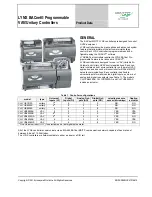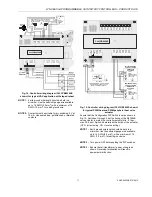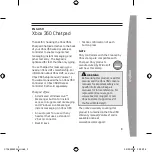
LYNX BACNET PROGRAMMABLE, VAV/UNITARY CONTROLLERS – PRODUCT DATA
EN0Z-0959GE51 R0615
14
CHECKOUT
Step 1. Check Installation and Wiring
Inspect all wiring connections at the controller terminals, and
verify compliance with installation wiring diagrams. If any
wiring changes are required,
first
be sure to remove power
from the controller
before
starting work. Pay particular
attention to:
24 Vac power connections. Verify that multiple controllers
being powered by the same transformer are wired with the
transformer secondary connected to the same input
terminal numbers on each controller. Use a meter to
measure 24 Vac at the appropriate terminals (see Fig.
10). Controller configurations are not necessarily limited to
three devices, but the total power draw, including
accessories, cannot exceed 100 VA when powered by the
same transformer (U.S., only).
Ensure that each controller has terminal 3 wired to a
verified earth ground, using a wire run as short as possible
with the heaviest gauge wire available, up to 2.0 mm
2
with
a min. of 1.0 mm
2
for each controller in the group (see Fig.
10).
Check that the MS/TP network polarity has been con-
nected properly on each controller. BACnet MS/TP is
polarity sensitive; communication will be lost for the entire
segment if one controller is connected improperly (see
Fig. 11).
Verify that triac wiring of the digital outputs to external
devices uses the proper load power and 24 Vac common
terminal (digital output common terminals) for high-side
switching.
NOTE:
All wiring must comply with applicable electrical
codes and ordinances or as specified on
installation wiring diagrams.
For guidelines for wiring run lengths and power budget, see
section “Power” on page 6.
Verify End-of-Line Termination Resistor Placement
The installation wiring diagrams should indicate the locations
for placement of the end of line termination resistors. See Fig.
11.
Correct placement of the end-of-line termination resistors is
required for proper BACnet MS/TP Bus communications.
Step 2. Startup
See Fig. 20 and the following text for startup information.
CLLYVB6438NS
DO-
1
DO-
2
DO-
4
DO-
6
DO-
8
COM
COM
COM
COM
DO-
3
DO-
5
DO-
7
BAC
+
BAC
-
24V
AC
20VDC
EGN
D
S-
BUS
S-
BUS
24
VA
C
CO
M
AO
-1
DI
-1
DI
-2
AO
-2
AO
-3
CO
M
CO
M
CO
M
DI
-3
DI
-4
20
VD
C
UI
-1
CO
M
UI
-2
UI
-3
CO
M
UI
-4
UI
-5
CO
M
UI
-6
BACnet MS/TP MAC
ADDRESS DIP SWITCHES
LOCAL BACnet MS/TP
MOLEX CONNECTOR PINS
HOST
STATUS
LED
21 22 23 24 25 26 27 28 29 30 31 32 33 34 35 36 37 38 39 40
1
3 4 5 6
2
7 8
9 10 11 12 13 14 15 16 17 18 19 20
Fig. 20. LED, service, network, and terminal connections
(CLLYVB6438NS shown)
Set the MS/TP MAC Address
The MS/TP MAC address DIP switches are used to set the
unit's MAC address. Each LYNX controller on an MS/TP
network must have a unique MAC address in the range of 0-
127 (address 0 should be avoided as it is the Honeywell
factory default MAC address for all MS/TP devices).
Controller Status LED
The LED on the front of the controller provides a visual
indication of the status of the device. When the controller
receives power, the LED appears in one of the following
allowable states, as described in Table 6.
Table 6. Status LED states
LED state
blink rate
status or condition
OFF
not applicable
No power to CPU, LED
damaged, low voltage to
board, first sec of power-up, or
loader damaged.
ON ON
steadily,
not
blinking
CPU not operating. Application
Program CRC being checked.
This takes 1-2 sec and occurs
on each restart (power-up,
reset, and reflash, and
following configuration file
download).
very slow
blink (con-
tinuous)
1 sec ON, 1 sec
OFF
Controller is operating
normally.
slow blink
(continuous)
0.5 sec ON, 0.5
sec OFF
Controller alarm is active or
controller in process of con-
figuration file download.
medium
blink (con-
tinuous)
0.3 sec ON, 0.3
sec OFF
Controller is in reflash mode or
awaiting / receiving reflash
data via BACnet.
BACNET Status LED
The LED on the front of the controller, between the BACnet
MS/TP terminals and MAC Address DIP Switches, provides a


































